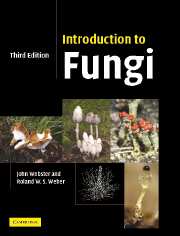Book contents
- Frontmatter
- Contents
- Preface to the first edition
- Preface to the second edition
- Preface to the third edition
- Acknowledgements
- 1 Introduction
- 2 Protozoa: Myxomycota (slime moulds)
- 3 Protozoa: Plasmodiophoromycota
- 4 Straminipila: minor fungal phyla
- 5 Straminipila: Oomycota
- 6 Chytridiomycota
- 7 Zygomycota
- 8 Ascomycota (ascomycetes)
- 9 Archiascomycetes
- 10 Hemiascomycetes
- 11 Plectomycetes
- 12 Hymenoascomycetes: Pyrenomycetes
- 13 Hymenoascomycetes: Erysiphales
- 14 Hymenoascomycetes: Pezizales (operculate discomycetes)
- 15 Hymenoascomycetes: Helotiales (inoperculate discomycetes)
- 16 Lichenized fungi (chiefly Hymenoascomycetes: Lecanorales)
- 17 Loculoascomycetes
- 18 Basidiomycota
- 19 Homobasidiomycetes
- 20 Homobasidiomycetes: gasteromycetes
- 21 Heterobasidiomycetes
- 22 Urediniomycetes: Uredinales (rust fungi)
- 23 Ustilaginomycetes: smut fungi and their allies
- 24 Basidiomycete yeasts
- 25 Anamorphic fungi (nematophagous and aquatic forms)
- References
- Index
- Plate section
7 - Zygomycota
- Frontmatter
- Contents
- Preface to the first edition
- Preface to the second edition
- Preface to the third edition
- Acknowledgements
- 1 Introduction
- 2 Protozoa: Myxomycota (slime moulds)
- 3 Protozoa: Plasmodiophoromycota
- 4 Straminipila: minor fungal phyla
- 5 Straminipila: Oomycota
- 6 Chytridiomycota
- 7 Zygomycota
- 8 Ascomycota (ascomycetes)
- 9 Archiascomycetes
- 10 Hemiascomycetes
- 11 Plectomycetes
- 12 Hymenoascomycetes: Pyrenomycetes
- 13 Hymenoascomycetes: Erysiphales
- 14 Hymenoascomycetes: Pezizales (operculate discomycetes)
- 15 Hymenoascomycetes: Helotiales (inoperculate discomycetes)
- 16 Lichenized fungi (chiefly Hymenoascomycetes: Lecanorales)
- 17 Loculoascomycetes
- 18 Basidiomycota
- 19 Homobasidiomycetes
- 20 Homobasidiomycetes: gasteromycetes
- 21 Heterobasidiomycetes
- 22 Urediniomycetes: Uredinales (rust fungi)
- 23 Ustilaginomycetes: smut fungi and their allies
- 24 Basidiomycete yeasts
- 25 Anamorphic fungi (nematophagous and aquatic forms)
- References
- Index
- Plate section
Summary
Introduction
The phylum Zygomycota comprises the first group of fungi considered in this book which lacks any motile stage. Asexual reproduction is by spores which are called aplanospores because they are non-motile, and sporangiospores because they are typically contained within sporangia. They are dispersed passively by wind, insects and rain splash, although violent liberation of entire sporangia (e.g. Pilobolus) or individual spores (e.g. Basidiobolus, Entomophthora) can also occur. Sexual reproduction is by gametangial copulation which is typically isogamous and results in the formation of a zygospore. The mycelial organization is coenocytic, and the cell wall contains chitin and its deacetylated derivative, chitosan (Bartnicki-Garcia, 1968, 1987; see Fig. 1.5). As in the Chytridio-, Asco- and Basidiomycota, the mitochondria possess lamellate cristae, and the Golgi system is reduced to single cisternae. Lysine is synthesized by the α-aminoadipic acid (AAA) route, as it appears to be in all Eumycota.
General accounts of the Zygomycota have been given by Benjamin (1979), Benny (2001) and Benny et al. (2001). Molecular evidence indicates that the group may have diverged from the Chytridiomycota early in the history of terrestrial life. The Zygomycota, in turn, probably gave rise to the Asco- and Basidiomycota, i.e. the ‘higher fungi’ (Jensen et al., 1998; Schüssler et al., 2001). Two classes are included in the Zygomycota, namely Zygomycetes comprising 870 species in 10 orders, and Trichomycetes with 218 species in 3 orders (Kirk et al., 2001). The most prominent orders of the Zygomycetes are the Mucorales, Entomophthorales and Glomales.
- Type
- Chapter
- Information
- Introduction to Fungi , pp. 165 - 225Publisher: Cambridge University PressPrint publication year: 2007



